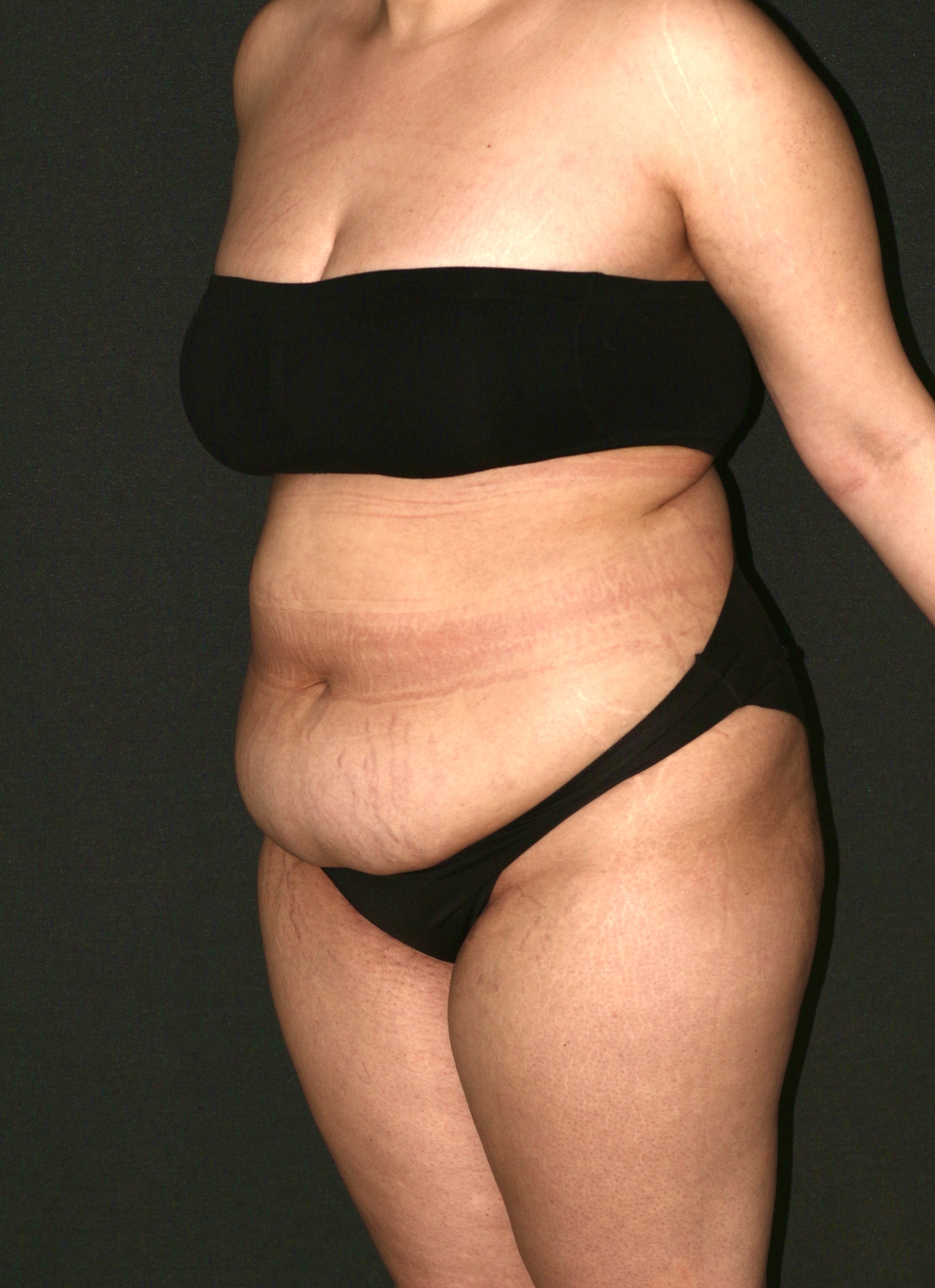Tummy Tuck (Abdominoplasty)
Tummy tuck surgery, also known as abdominoplasty, is a cosmetic surgical procedure that is designed to improve the appearance of the abdomen by removing excess skin and fat and tightening the underlying muscles. This procedure is commonly performed on individuals who have lost a significant amount of weight, have excess skin and fat in the abdominal area due to pregnancy, or simply want to achieve a more toned and sculpted midsection.
During a tummy tuck procedure, the surgeon will make an incision in the lower abdominal area, typically below the bikini line. The length and location of the incision will depend on the extent of the surgery and the individual's anatomy. The surgeon will then remove excess skin and fat from the abdominal area, and may also tighten the underlying muscles to create a more toned and defined appearance. The remaining skin is then pulled tight and sutured into place, creating a smoother, more contoured appearance.
In some cases, liposuction may be used in conjunction with tummy tuck surgery to further enhance the results. This may involve removing excess fat from the surrounding areas, such as the hips or thighs, to create a more balanced and aesthetically pleasing appearance.
Tummy tuck surgery is typically performed under general anesthesia, and patients may need to spend one or more nights in the hospital following the procedure. Recovery time varies depending on the extent of the surgery and the individual's healing process, but most patients can expect to resume normal activities within several weeks to a few months. During the recovery period, patients may experience some discomfort, swelling, and bruising in the abdominal area, and will need to avoid strenuous activity and heavy lifting for several weeks.
Overall, tummy tuck surgery can be an effective way to achieve a more toned and sculpted midsection, and can help to improve both appearance and self-confidence. However, it is important to have realistic expectations and to consult with a qualified and experienced plastic surgeon to determine if this procedure is right for you.
Am I a good candidate for Tummy Tuck?
Whether or not you are a good candidate for a tummy tuck procedure depends on a variety of factors, including your overall health, the extent of your abdominal concerns, and your expectations for the results of the procedure.
In general, good candidates for tummy tuck surgery are individuals who:
Have excess skin or fat in the abdominal area that does not respond to diet and exercise
Have loose or sagging abdominal muscles
Have realistic expectations for the results of the procedure
Are in good overall health and do not have any medical conditions that could increase the risk of complications during surgery or recovery
Do not smoke or are willing to quit smoking for a period of time before and after the procedure, as smoking can increase the risk of complications and delay healing.
It is also important to note that tummy tuck surgery is not a weight loss procedure and should not be used as a substitute for proper diet and exercise. While the procedure can help to improve the appearance of the abdomen and create a more toned and defined midsection, it is not designed to help individuals lose large amounts of weight.
To determine if you are a good candidate for a tummy tuck procedure, it is important to consult with a qualified and experienced plastic surgeon. Your surgeon will evaluate your medical history, perform a physical examination, and discuss your goals and expectations for the procedure. Based on this information, your surgeon can help you determine if a tummy tuck is right for you and develop a customized treatment plan that is tailored to your individual needs and goals.
What are the risks and benefits of tummy tuck (abdominoplasty)?
As with any surgical procedure, tummy tuck surgery (abdominoplasty) carries both risks and benefits. It is important to be aware of both before making a decision about whether to undergo the procedure.
Risks:
Infection: Like all surgeries, there is a risk of infection following a tummy tuck. Your surgeon will prescribe antibiotics to reduce this risk.
Bleeding: Any surgery carries the risk of bleeding, which can be serious if it is excessive. Your surgeon will monitor you closely for signs of bleeding.
Scarring: The incision made during a tummy tuck will leave a scar, which can be significant depending on the extent of the procedure. Your surgeon will make every effort to minimize scarring, but it cannot be eliminated entirely.
Numbness or other changes in sensation: Some patients experience numbness or changes in sensation in the abdominal area after a tummy tuck. These symptoms are usually temporary but may be permanent in some cases.
Seroma: A seroma is a collection of fluid that can develop under the skin after a tummy tuck. This is more common in patients who have had large amounts of fat removed from the abdominal area.
Blood clots: There is a risk of blood clots forming in the legs or lungs after any surgery, including a tummy tuck.
Benefits: Improved appearance: A tummy tuck can significantly improve the appearance of the abdominal area, removing excess skin and fat and creating a more toned and sculpted midsection.
Improved self-confidence: Many patients report feeling more confident and self-assured after a tummy tuck, particularly if they have been self-conscious about their abdominal appearance for many years.
Improved physical comfort: Excess skin and fat in the abdominal area can cause physical discomfort, including back pain, posture problems, and skin irritation. A tummy tuck can help to alleviate these symptoms.
Improved clothing fit: Clothes may fit better after a tummy tuck, as excess skin and fat are removed from the abdominal area, creating a more streamlined silhouette.
It is important to discuss both the risks and benefits of tummy tuck surgery with your plastic surgeon before making a decision about whether to undergo the procedure. Your surgeon can help you determine if a tummy tuck is right for you based on your individual medical history, goals, and expectations for the procedure.
How to get ready for tummy tuck?
Preparing for a tummy tuck (abdominoplasty) procedure is an important part of ensuring a smooth and successful outcome. Here are some tips on how to get ready for a tummy tuck:
Consult with a qualified plastic surgeon: The first step in preparing for a tummy tuck is to consult with a board-certified plastic surgeon who is experienced in performing the procedure. Your surgeon will evaluate your medical history, perform a physical examination, and discuss your goals and expectations for the procedure. Based on this information, your surgeon can develop a customized treatment plan that is tailored to your individual needs and goals.
Stop smoking: If you smoke, it is important to quit smoking at least six weeks before your tummy tuck procedure. Smoking can increase the risk of complications during and after surgery, including delayed healing, infection, and poor wound healing.
Follow your surgeon's instructions: Your surgeon will provide you with specific instructions on how to prepare for your tummy tuck, including guidelines on eating, drinking, and taking medications before the procedure. It is important to follow these instructions carefully to ensure the best possible outcome.
Prepare for recovery: You will need to take time off from work and other activities to recover from your tummy tuck. Make sure to arrange for someone to help you with household chores and childcare, if needed. You may also need to purchase compression garments and other supplies to aid in your recovery.
Get in good physical shape: While a tummy tuck is not a weight loss procedure, being in good physical shape can help to optimize your results and minimize the risk of complications. Your surgeon may recommend that you lose weight or improve your fitness level before undergoing the procedure.
Manage your expectations: It is important to have realistic expectations for the results of your tummy tuck. Your surgeon can help you understand what to expect in terms of scarring, recovery time, and overall outcome.
By following these steps, you can help to ensure a smooth and successful tummy tuck procedure and recovery.
How to take care of yourself after a tummy tuck?
Proper postoperative care is essential to ensure a smooth recovery after a tummy tuck (abdominoplasty) procedure. Here are some tips on how to take care of yourself after a tummy tuck:
Follow your surgeon's instructions: Your surgeon will provide you with specific instructions on how to care for yourself after your tummy tuck, including guidelines on bathing, dressing changes, and medications. It is important to follow these instructions carefully to minimize the risk of complications and ensure a successful recovery.
Take it easy: Rest and relaxation are essential to a smooth recovery after a tummy tuck. Avoid strenuous activities, lifting heavy objects, and bending or twisting for several weeks after the procedure.
Wear compression garments: Your surgeon may recommend that you wear a compression garment or binder after your tummy tuck to help reduce swelling and support the healing process. Make sure to wear the garment as instructed and keep it clean and dry.
Manage pain and discomfort: It is normal to experience some pain and discomfort after a tummy tuck. Your surgeon will prescribe pain medication to help manage these symptoms. Make sure to take your medication as directed and report any concerns or unusual symptoms to your surgeon.
Stay hydrated and eat a healthy diet: Staying hydrated and eating a healthy, balanced diet can help to support the healing process after a tummy tuck. Make sure to drink plenty of water and eat nutrient-rich foods such as fruits, vegetables, and lean protein sources.
Attend follow-up appointments: Your surgeon will schedule follow-up appointments to monitor your recovery and check your progress. Make sure to attend these appointments and report any concerns or questions you may have.
Avoid smoking and alcohol: Smoking and alcohol can interfere with the healing process and increase the risk of complications after a tummy tuck. It is important to avoid smoking and alcohol for several weeks before and after the procedure.
By following these tips, you can help to ensure a smooth and successful recovery after your tummy tuck procedure. Be sure to discuss any concerns or questions you may have with your surgeon, and seek medical attention immediately if you experience any unusual symptoms or complications.
How is the healing process and scarring after tummy tuck?
The healing process and scarring after a tummy tuck (abdominoplasty) can vary depending on a variety of factors, including the extent of the procedure, the patient's age and overall health, and how well they follow their surgeon's postoperative instructions.
Here are some general guidelines on what to expect during the healing process and how scarring may develop:
Immediately after surgery: After your tummy tuck procedure, you will be taken to a recovery area where you will be closely monitored as you wake up from anesthesia. You may experience some discomfort, swelling, and bruising during this time.
First few days: In the first few days after your tummy tuck, you will need to rest and avoid strenuous activities. You may experience some pain and discomfort, but your surgeon will prescribe pain medication to help manage these symptoms. You will need to wear a compression garment or binder to help reduce swelling and support the healing process.
First few weeks: Over the first few weeks after your tummy tuck, you will gradually begin to resume normal activities. You may still experience some swelling and bruising, but these should begin to improve over time. Your surgeon will provide you with specific instructions on when you can resume exercise and other physical activities.
Scarring: Scarring is an inevitable part of any surgical procedure, including a tummy tuck. Your surgeon will make incisions along your lower abdomen, which will leave a scar that will initially appear pink or red. Over time, the scar will fade and become less noticeable, although it may never completely disappear. The final appearance of your scar will depend on several factors, including the size and location of the incisions and how well you care for your skin during the healing process.
Long-term recovery: The full recovery time after a tummy tuck can vary depending on the extent of the procedure and the individual patient's healing process. Most patients are able to resume normal activities within six to eight weeks after surgery. Your surgeon will schedule follow-up appointments to monitor your progress and ensure that your recovery is progressing as expected.
It is important to keep in mind that the healing process after a tummy tuck can be a gradual and ongoing process. It is important to follow your surgeon's instructions carefully, including keeping the incision sites clean and protected from the sun. Over time, the scars will fade and you should begin to see the final results of your tummy tuck procedure.









